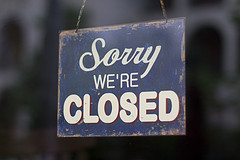 Every fews months (often longer), direct mail guru and copywriting genius, Alan Rosenspan, sends out his newsletter (subscribe here). It’s one of our favorites and always includes an item or two worth thinking about. This past week, the newsletter posed this question from Jerry Reitman, ex-head of Ogilvy & Mather Direct and integrated marketing at Leo Burnett:
Every fews months (often longer), direct mail guru and copywriting genius, Alan Rosenspan, sends out his newsletter (subscribe here). It’s one of our favorites and always includes an item or two worth thinking about. This past week, the newsletter posed this question from Jerry Reitman, ex-head of Ogilvy & Mather Direct and integrated marketing at Leo Burnett:
“What do you think are the first early indicators that your business is in a state of long-term decline?”
This is how Mr. Rosenspan answered:
1. The demographics turn against you. You may be serving a customer base that is either not growing or shrinking. An example would be the cigar industry, although they have been somewhat successful in attracting younger people and also women.
2. Your costs are going up, but not your revenue. If you cannot charge more for your product, or enhance it in any way, you will gradually surrender your margin as all other costs increase, such as labor, distribution and even raw materials.
This is also true of your marketing costs. If the cost of acquiring a customer keeps going up—but the value of the customer stays about the same—you will soon be in trouble.
3. You have a limited product range. If you only sell one or two products, it’s much harder to increase customer value.
4. Your company is not innovating—while others in the category are. As the title of a recent business book read, “It’s not the big that eat the small; it’s the fast that eat the slow.”
5. You are experiencing more customer dissatisfaction. This is sometimes hard to detect—for example, if you work through channels or agents—but it’s always worth exploring. Early indicators might be lapsing customers, higher return rates, shrinking distribution.
6. You’re in the “middle” with limited added value. Technology has enabled customers to bypass the middle and buy directly from producers. For example, the travel industry looks very different now than it has in the past.
7. You sell a commodity—like books, CDs or DVDs. This makes you especially vulnerable because people can buy the same items from anyone else. You need to create something that makes your company different and better.
We are living in an age where almost any business can be marginalized, virtually overnight. If any of these warning signs are true of your company, you need to act quickly.
Good questions for any small business owner to ponder. And if the startup you’re working on has one or more of these characteristics, you may want to think twice about the idea—or even better, think about how you can avoid the pitfall of business decline.
Photo credit: Nick Papakyriazis via photopin cc



